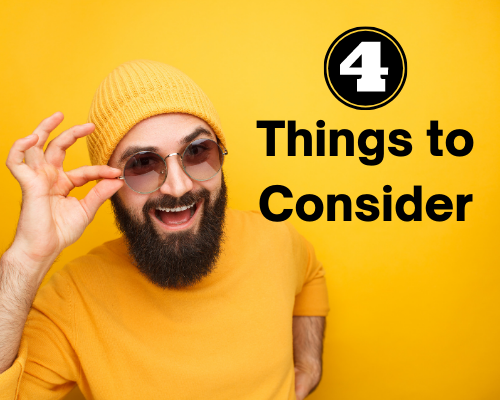In addition to wearing a hat and sunscreen on the exposed parts of your body, be sure to protect your eyes with a comfortable pair of sunglasses for hiking.
There are so many aspects to consider when buying the best hiking sunglasses, and style is just one of them. Factors like the type of lenses you prefer, the level of protection you need, and the materials you want your sunglasses to be made from all play a part. While these glasses won’t make you go faster or higher, they will make your outdoor adventures much more enjoyable – especially when the weather is cooperating.
This post contains some affiliate links to products that I use and love. If you click through and make a purchase, I’ll earn a commission, at no additional cost to you. Read my full disclosure here.
Hiking sunglasses are a little different from your everyday shades. You want something that is lightweight, but that will protect your eyes no matter where you are or what you are doing. If you are buying hiking sunglasses, you can’t just go to the mall and pick up a cheap pair. You need something that will last through all the various terrains, weather, and activities you’ll be facing.
In This Article
4 Things to Consider When Purchasing Hiking Sunglasses

We all like to be stylish. But there are more important things to consider when buying quality sunglasses. Here are four things to consider when purchasing sunglasses for hiking.
1) Function versus Style
This is probably the biggest reason why people buy hiking sunglasses. They want something that looks good but doesn’t fall apart when they take them out for a hike. Depending on your level of comfort and where you live, you will need to choose between a lightweight, flexible pair or something more durable. Obviously, the latter will provide greater protection against wind and water damage. However, these glasses will be heavier, bulkier, and not as versatile.
You’ll most likely want a pair of sunglasses that fits comfortable within the middle of these two options. It will be easier to find a pair that works for you, and you’ll be able to wear them in different environments without feeling like you are wearing two different pairs of glasses.
2) UV Protection
Your eyes are one of your most important organs, so it’s understandable that you would want to make sure they’re safe from harm when hiking or doing other outdoor activities. You will need a pair of sunglasses that offers UV protection that’s as great as or greater than what you get from your regular glasses.
Although all of the options listed here are considered to be “hiking sunglasses”, you might want to consider getting an additional pair for outdoor activities like swimming or fishing. When you take them out for these types of activities, your eyes can get some serious sun damage which will take a toll on their overall effectiveness in protecting against UV rays.
3) Frame Material
There are three main materials used in the construction of hiking sunglasses: plastic, metal alloy, and more recently, carbon fiber.
Plastic
If you’re looking for something lightweight and flexible, plastic is the material of choice for hiking sunglasses. A pair of these scratch-resistant lenses will allow the glasses to bend without breaking no matter how hard you try. Plastic is also easy to clean and disinfect after a day outside. If you’re not worried about getting rid of scratches, then plastic may be all you need. It’s important to note that plastic will scratch more easily than metal or carbon fiber.
Metal Alloy
Carbon fiber can handle a lot more than plastic; however, it can be a little bit more expensive and difficult to find because it’s still being researched in most places around the world. It’s also not very easy to clean since it tends to absorb microscopic particles.
Carbon fiber is a composite material that is made from an inter-woven carbon thread that’s usually a little more flexible than plastic. This makes it easier to mold into the style of sunglasses you’re looking for, without compromising the glasses’ durability. It’s also both lightweight and strong, which is a definite plus. You can’t use metal alloy as an all-purpose material for your hiking sunglasses, but as long as you’re not looking for plastic or carbon fiber, this could be a good option.
4) Frame Size
The size of the frame is usually determined by the frame’s materials and its purpose. Plastic and metal alloy will be smaller than their carbon fiber or plastic counterparts, but you should be able to pick whichever option feels most comfortable to you. You can always get a pair of sunglasses with a larger frame if it’s something you’ll use in place of regular glasses or an everyday pair . When buying hiking sunglasses, choose a model that fits your face shape so that they aren’t uncomfortable when worn all day.
Morning Hiker Recommendations for Hiking Sunglasses
Our top (inexpensive) recommendation for hiking sunglasses is Bevi Sports Polarized Glasses. They offer UV400 protection with a 7 layer construction. It is made of thermoplastic material which is durable and lightweight. It is rated to block 100% harmful UVA & UVB Rays. Plus it is stylish and reasonably priced.

Learn More About Bevi Sunglasses
If you are willing to spend more, the Bose Polarized Sport Sunglasses offer great protection plus open ear audio. They are water resistant with Interchangeable lenses.

Learn More about Bose Sunglasses
Best Sport Sunglasses Over $100
Other Considerations:
A few other things to consider when buying hiking sunglasses include the amount of coverage you need, how much you’re willing to spend, and whether or not you want sunglass/eyeglass shades or prescription sunglasses. The amount of coverage needed will depend on what type of activities and weather conditions that you’ll be facing. For example, goggles may be the best option for surfers, bikers, and skiers.
Depending on how much you plan to spend is another factor that deserves consideration. If money is a concern, then consider purchasing a pair of less expensive sunglasses as a backup pair. Sunglasses can be expensive to purchase if they aren’t something that you’ll wear regularly. If you can afford to spend a little extra money, then it could be worth it to get something that’s made of metal alloy or carbon fiber.
As with all other types of glasses, prescription sunglasses are an option. What’s most important is that you’re able to see clearly while wearing your new pair. Make sure to check the manufacturer’s website or contact them directly for further assistance if you have any questions about the glasses’ visibility.
Backup Pair
If you’re planning on buying sunglasses for hiking and other outdoor activities like running or biking, then it may be worth it to invest in a backup pair. If you end up damaging your new pair, you’ll be able to get another pair of glasses for a fraction of the cost. Of course, there are some people that are comfortable wearing multiple pairs at once as they like to mix and match their styles, but if this is something you’re not interested in, then just consider buying two pairs that look alike as a backup pair.
Price
Prices vary greatly from one company to the next, but generally speaking, quality sunglasses will cost more than low-quality ones. You may also have to purchase prescription sunglasses separately in order to have them custom fitted for your eyes.
You should also check to see what types of warranties are provided or how long they’re guaranteed to last. If you discover that your sunglasses aren’t as durable as you’d like them to be, it may only cost a single pair of glasses if you’re able to send back the sunglasses for repairs or replacement.
Best Sport Sunglasses Under $25
What are the levels of sunglass protection?
Over the years, many people that have experienced contact allergies and skin cancer due to prolonged exposure to the sun have found relief when they’ve switched from regular sunglasses to specific kinds of photochromic lenses. Since these types of lenses can change opacity in the same way that regular glasses do, this type of product is used by a wide variety of people.
However, what if you’re looking for something that offers additional protection? There are certain kinds of glasses available today that provide additional levels of photochromic protection.
Categories of UV Protection
According to the American Cancer Society (ACS), there are several different ways that conventional sunglasses may protect your eyes from the sun. However, they also make it clear that there are many different kinds of photochromic lenses and other products on the market today.
The ACS recommends looking at the list below to determine which levels of protection your lenses will offer.
High UV Protection
This is a category often referred to as high index lens protection (HIP). According to the ACS, HIP sunglasses provide an all-around level of protection that’s roughly equivalent to regular sunglasses with these lenses installed. It’s important to note that the lenses in this category are not designed or certified as photochromic.
Photochromic
These sunglasses provide a greater level of protection than the Hight index glasses. According to the ACS, these types of sunglasses give off less visible light when the lens automatically changes its opacity, but they are also capable of providing full UV protection. This category is one that’s closely tied to photo-chromic lenses and can be difficult for many consumers to understand (and even difficult for some professionals to explain).
Photo-Protective
Protection at this level is referred to as photo-protective, and it’s actually just an extension of high index protection (HIP). To provide the highest level of protection at an affordable price, this class uses a special UV coating that’s applied to polycarbonate lenses. A manufacturer can’t use this type of coating with glass lenses because the glass doesn’t allow for the UV rays to pass through.
Not every category will be available from every eyewear manufacturer, and not every manufacturer has created a universal system to help shoppers better understand their options, but understanding these terms allows you to make a more informed decision when you’re shopping for sunglasses or clear eyeglasses.
The EU lists 5 categories of UV protection:

How to Tell if Your Current Sunglasses Are Protecting Your Eyes
TheAmerican Academy of Ophthemology recommends sunglasses that meet these requirements:
- Blocks 99 percent of ultraviolet rays
- Lens are ground and polished
- Glasses are impact resistant
- Polarized lenses
- Photochromic (automatically darken in bright light)
- Wraparound style (to cover sides of eyes)
- Gradient lenses (dark on top and lighter on bottom)
- Blocks 90% of infrared rays
- Blue-blocker
Final Thoughts on Hiking Sunglasses
Hiking is a sport of preparation. Being ready for the unexpected is part of what makes the outdoors so appealing. Making sure you are protected from damaging and harmful sunlight will ensure you have a good outdoor experience.
Making sure you have the best hiking sunglasses will keep your eyes protected.
For a list of available products, visit our online shop.



We are participants in the Amazon Services LLC Associates Program, an affiliate advertising program designed to provide a means for sites to earn advertising fees by advertising and linking to Amazon.com